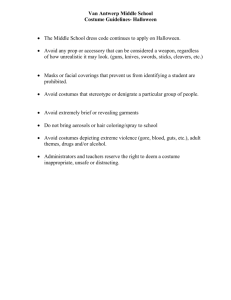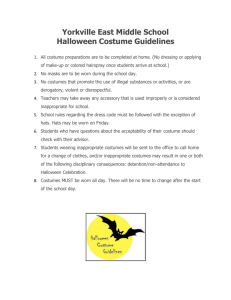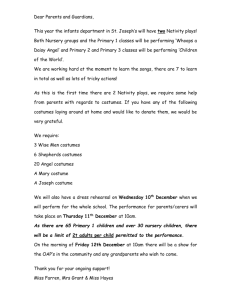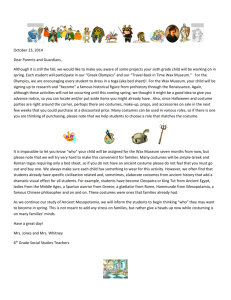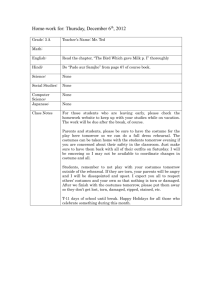Document 10995551
advertisement
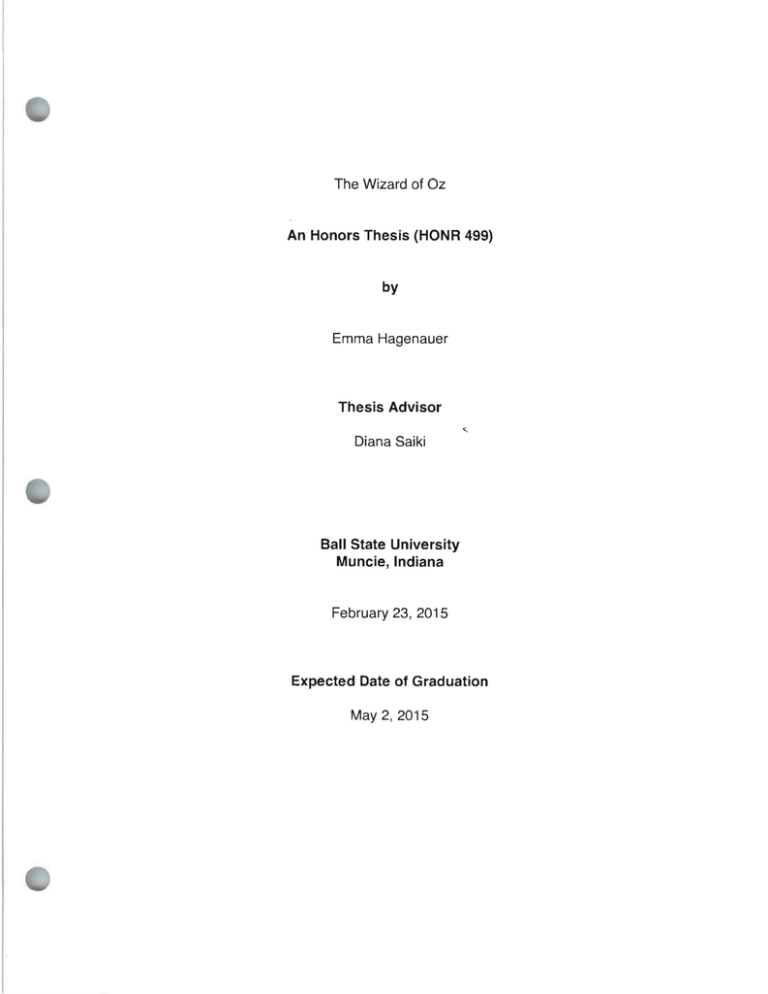
The Wizard of Oz An Honors Thesis (HONR 499) by Emma Hagenauer Thesis Advisor Diana Saiki Ball State University Muncie, Indiana February 23, 2015 Expected Date of Graduation May 2,2015 ABSTRACT The theatre has been a way for people to share artistic vision and a story. The Wizard of Oz is considered a classic book, film and play. After researching the stories and various mediums and stage costuming techniques, I designed the costumes for the Wizard of Oz musical by the St. Simon Catholic Church in Indianapolis. 2 ACKNOWLEDGEMENTS Thank you to Suzanne Collins, who gave me the chance to break into a new area of fashion design I had not had the chance to experiment with yet; you were an amazing source of inspiration and a lovely role model during this project. Thank you to Karen Rulong and all the parents who were always quick to assist me in whatever I needed. A huge thank you to the actors and actresses, who not only rocked the stage, but were so much fun to work with. Thank you to Tyler Grube for being a great friend and letting me hijack your sewing machine. To my friends and family who were patient while I worked on this, drove me to rehearsals and gave me their honest opinions, thank you all! Lastly, thank you to Diana Saiki for always giving me great guidance and advice. 3 AUTHOR'S STATEMENT I chose to design the costumes of The Wizard of Oz show to give me insight into the world of theatrical costuming , one I had never had a chance to enter before . I have always loved and admired the theater so I took this opportunity very seriously. Before beginning to design the costume scheme for this show there were vital elements to take into consideration. Reading the script was important along with analyzing the setting, plot, characterizations , and relationships. Costume designer Judith Bowden said, "The main job of costume design in a production is to provide physical and emotional support to every actor through the clothing he or she will wear to enhance Characterization." This was the platform I used to start the development of these costumes. This is what I wanted my end result to reflect. As a fashion merchandising major, I have a solid knowledge of garment construction and visual presentation. Dealing with theatrical costumes utilized my knowledge of cloth ing, but I also had to work with a new set of rules. Some key differences were the fluidity of a play and the unexpected twists that may occur. I had to think about not just making and finding outfits, but about the characters and their personalities, as well as their role in a given scene and in the play itself. Since the show has so many chorus numbers, I chose to focus first on the scene, and then on each character and how they fit into it. There were three primary factors I focused on when costuming each scene; the expectations of this production, the place the scene occurred, and the audience. The Expectations Knowing the expectations of this production helped me start to shape my costumes. This included the popularity of the show itself, the challenges and joys of working with a younger cast, as well as, all time and money constraints. Since the 1939 movie version is the most well known adaptation of the play, and most well known to the audience, that was where I looked for inspiration before I began designing for the play. It was important to me to make the costumes recognizable and true to the story, yet make them original. I had to take into consideration that children in middle school were performing in this play. Not only did the costumes need to be fitting for a younger demographic, I also wanted them to be enjoyable for the performers to wear. One drawback was that I was living, working , and attending school in Muncie during the preparation of this show. I could not be at most rehearsals and meetings, which made things more difficult. Set times to talk with the director were required, as well as constant e-mail communications to share ideas, sketches, pictures, and progress. These factors, while sometimes discouraging, were helpful in setting strict deadlines for myself and deciding how to costume the show. 4 Working within the budget of the school was a big aspect of designing the costumes. All personal and school related resources were utilized to ensure that I stayed within the budget. I worked to find thrifty options; if there is one lesson I learned from my sewing classes it was how to effectively utilize Jo Ann Fabric coupons. The parents were also helpful in aiding when they could, purchasing small pieces and using their resources. A classic group of characters depicted in the film are the Wicked Witch's personal soldiers, the winkies and the flying monkeys. These are characters who have little dialogue, but specific characteristics that make them well remembered by the audience. I had to create effective costumes for these characters, but had to be creative in finding a way to make them within the budget. We debated how to approach the costumes of the winkies . In the movie they wore multiple layers and to create similar costumes would have used a lot of fabric. A parent found a high school that had made winkie costumes for a past show and were willing to lend them. While they were a bit large on most of the boys, they worked out well and saved a large sum of money and time spent on making them. Hats were made to reflect the large, furry hats worn in the movie (Figure 1). In the movie, the monkeys had cape-like vests that had a signature design of red, blue, and grey as well as matching hats. I modified the look to a sleeveless vest, which made it easier for the actors to move and jump around the stage (Figure 2). I also made a hat by covering a plastic cup with felt and a matching deSign. This was an inexpensive and easy method to make a stiff hat. It also looked great from the audience. In the movie, the monkey fur looked similar to a cotton sweatshirt and sweatpants. Since I knew most kids would have that or be able to get one, I decided to have them turn grey sweat pants and shirts inside out underneath the vest. We turned butterfly wings into monkey wings by spray­ painting them at the back and curving the ends (Figure 3). 5 Place A major factor was the place each scene occurred. Not just the physical location, but what symbolism and feeling came with that scene, what the costumes needed to communicate and how the characters would be moving in them. Some characters kept their costumes the whole time, but the majority of the characters are only in one setting, so thinking about the place first, before the character, helped me create cohesive chorus scenes that truly represented the essence of the place. 6 Figure 5 Kansas is where the story begins. Dorothy is introduced as the protagonist in the story and her background of living on her Aunt and Uncle's farm is shown. Taking inspiration from the 1939 movie version, which showed the Kansas scenes in black and white, we did the Kansas scenes completely in brown and gray scale colors to have a deeper impact when Dorothy lands in colorful Oz (Figure 4). Although Kansas is Dorothy's home, she is unhappy in the first scene and anxious to go "somewhere over the rainbow" The gray colors aided in showing the monotonous life she lives. Every item including the set and props were in these colors to create the biggest impact possible (Figure 5). A dress was found at a thrift store that resembled the blue dress Dorothy wears in Oz, but was black and white instead. This was important because it showed the impact that Munchkinland had on Dorothy; it gave her a contagious burst of color and joy (Figure 6). The rest of the ensemble wore clothes that could be worn working on a farm. 7 Munchkinland is the first scene where color was introduced (Figure 6). This scene is crucial because the plot is introduced as well as some major characters such as Glenda and the Wicked Witch. The munchkins are exuberant and somewhat childlike. This is what I focused on when creating the look of the scene. The munchkins are living the life Dorothy dreams of; surrounded by beauty, playing and singing their days away. This pushed me to create a costume scheme that helped convey the great contrast to the previous scenes. The director and I wanted brightly colored whimsical costumes that would be easy to assemble and coordinate . We decided upon three main colors to use in the costuming, bright blue, purple and orange (Figure 7). This was limiting in some ways, but it gave a sense of order to the colorful chaos of the scene; we accepted any prints and patterns in those colors to create the playful look (Figure 8). Specific guidelines were given to the parents about the colors and what to wear. I made aprons for the girls to wear over their ensembles using three printed cotton fabrics, one in each color. I used contrasting color for the tie around the waist and attached flowers in contrasting colors to the front for an added whimsical detail (Figure 7). I wanted to use fabric with large prints, in the certain colors. I could not find exactly what I was looking for in fabric, so I added the flowers that ended up being the right amount of color for their outfits to be seen from the back of the house. I used the same material and made bowties for the boys (Figure 9). These accessories created a cohesive look for the whole scene. The set was developed around the same color theme as well. The lullaby league is a subgroup within this scene and I made hats for these young ballerinas. They had pink tutus, which reflects the traditional ballerina as well as the movie. I made tall hats out of tissue paper and poster board, with pink faux fur trim. To connect the colors chosen, I added purple 8 ribbon to tie around the girls' faces and a purple flower that was worn on top of the head (Figure 10). This prop was one of my favorites. When making it I was not sure how well it would come across on stage. Up close it looked slightly wrinkled, due to the tissue paper, and at first I made them too small. I made them larger the next time with larger flowers and decided to let the girls try them even with the wrinkles. The result was exactly right. You could not see the wrinkles from the audience, and even though the hats were so tall, they added just the right amount of whimsy to the munchkin girls (Figure 11). The set designer created houses with the colors we chose for the roof and windows, which made the whole scene feel enchanting; a perfect entrance into the world of Oz. While costuming this scene I utilized knowledge gained from visual merchandising. Similar to visual merchandising, I had to work with the set creators to get a cohesive look in order to sell the idea. The Emerald City was another setting in which the costumes and sets were crucial to conveying the emotions and attitude of the city. The name keeps no secret to what is held behinds its gates; green is everywhere. This location is filled with Ozians, the people who live in the Emerald City. They are high energy, flashy and guileless. Since it is the city, versus the more pastoral Munchkinland, I wanted the costumes to be classic and fancy. A high school donated its show choir uniforms, which were perfect for the group. The girls wore one of three dress styles, all with a sleeveless bodice, a full skirt and, sequins throughout. The boys had sequins, vests, bowties and bowler hats, which we paired with a white button down shirt and black pants (Figure 12). The Ozians are eccentric too, so I wanted everyone to wear a funky hat or headpiece. This added some creativity to the costume, and really looked good on stage. I made capes for the four doorkeepers. I was going to make them more fitted to the students, then decided to make them larger to add to the dramatic effect of the place. The Oz letters I attached to the capes had to be large enough to make an impact on the audience. In my previous course about the history of costume I remembered learning about power dressing and how garments can convey a sense of status or position. This inspired me to add large pointed shoulders to the capes to relay the importance of the characters' role as the guards at the gates of Oz (Figure 13). 10 Audience The audience was the last element I needed to consider. Parents, siblings and families of the performers were the audience. The remainder of the audience was friends of the performers, other students and teachers at St. Simon School. With this in mind, I wanted to make sure that the costumes could easily communicate the characters' personalities to people of all ages. I especially wanted to make sure the parents were pleased with the outcome after they had been taking time to transport the students to and from rehearsals, worked on creating costumes and sets, and put together various aspects of the show. In thinking about the audience, I observed the parents and children first. Most parents had little background in theatre, but were very excited that their child was participating in this play. I decided to make the costumes extremely clear, taking inspiration from the 1939 movie. There was one scene where there were jitterbug dancers and trees. This scene was cut from the movie. Therefore, I assumed most people were not going to have preconceived expectations of what the scene should look like. The director and I decided to make the jitterbug dancers wear red and black like a ladybug. I made choker necklaces for the girls that had polka dots to reference the ladybug, and designed antennas for the girls to wear which helped clearly show that these were bugs (Figure 14). The trees in this scene wore tree camouflage shirts and I made wreath-like head pieces out of leaves (Figure 15). Both sets of costumes were the same for each group of performers, and this gave the scene harmony that was easily relayed to the working closely with the director I learned more about what the audience wanted to see, and also what she wanted conveyed through this play. One aspect she wanted was the main characters, Dorothy, Tinman, Scarecrow, The Cowardly Lion, Wicked Witch, and Glenda to all have very recognizable 11 costumes (Figure 16 & 17). These costumes were all rented or found at thrift shops to look as close to the movie version as possible. Working closely with the director was a big part of understanding how to connect with the audience as well. She gave me creative freedom, but had specific things envisioned as well. When Tinman was introduced there were trees that throw apples at him, Dorothy, and Scarecrow. These costumes were a challenge. I wanted them to have a different look than the jitterbug trees, but had a difficult time coming up with something that would look convincing on stage. When discussing this with the director I found that Instead of purely malevolent trees, as in the movie, the characterization of these trees became more cheeky and spirited for the show. The director worked with the three girls who played these trees to make clever dialogue for the scene . This new attitude was the inspiration tor their costumes. Together we came up with a vision and I made skirts out of various shades of brown tulle. This created a great texture trom the audience's point-ot-view and I combined it with a headpiece and varying styles of neckpieces made of garland (Figure 18). 12 In Conclusion While I worked on this project I learned about The Wizard of Oz and stage costuming. However, I learned most about how to work with others from a distance, how to creatively collaborate, and that giving up control comes with this field. Every challenge posed a new way to approach the project and I think the outcome was stronger because of it. In my fashion and business classes I have learned about trends and done customer analyses to "figure out what a consumer might want. These were techniques I was not prepared to reference , but often did. The bulk of creative projects I have completed have been my work and my vision. However, this project had to be a balance of inspiration from the director; the parents ; Adrian Adolph Greenberg, the designer for the original film ; and finally myself. Learning how to effectively share a vision and collaborate is something I learned more through this independent project then anywhere else. This project gave me a chance to work in a new field and apply skills I have gathered thus far in my education; I am grateful that I had the opportunity to see it to fruition. 13 WORKS CITED Bowden , J . (n.d.). Secret life of costumes. Retrieved from http://www.artsalive.ca/collections/costumes/designer_role.php?lang=en Baum , L. F. (1998). The wonderful wizard of oz. New York: Penguin Classics. Fleming, V. (Director), & Vidor, K. (Director) (1939). The wizard of oz [VHS]. 14
